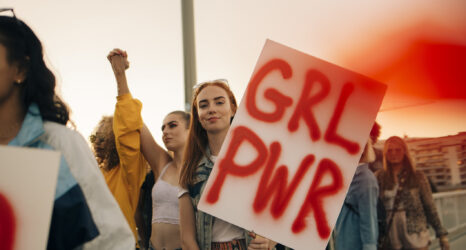The news cycle is flooded every day with more and more challenging issues facing our nation. In particular, two topics that I care deeply about have been taking center stage as of late: gender-based violence and climate change.
Over the last year, the #MeToo movement captured the country’s attention—making space, at last, for the stories of hundreds of sexual abuse survivors, transforming hundreds of celebrities into activists. And with unprecedented hurricanes, wildfires, an eroding infrastructure due to a rising sea level and record-breaking heat facing the same nation, climate change also become more personal—and political.
These two movements, though categorically different issues with separate impacts, actually have a great deal in common. And the opportunities to take action can be found in the same place.
#1: They are impacting real people.
For a long time, concepts like “patriarchy” and “climate change” were short answer questions in college exams, or written about illustratively in an occasional New Yorker article. It certainly didn’t show up on my Facebook feed or on mainstream media with any regularity. But this past year, that changed. Both climate change and gender-based violence are no longer abstract.
While te #MeToo movement took down celebrities in Hollywood and lawmakers in Washington, D.C., hurricanes decimated Houston, Puerto Rico and parts of Florida while wildfires overtook California. These growing climate disasters showcased the heroism and resolve that communities mustered in the face of climate impacts—and the #MeToo movement made silence breakers into national heroes.
We have now seen the faces of real people who have been impacted by sexual assault and by climate disasters. As a result, many people are now more personally feeling the trauma that these people have experienced and holding it with empathy.
#2: …And they’re specifically impacting women.
The #MeToo movement has served as a harrowing reminder of the ways in which structural inequalities in our culture have left women silenced, shamed and endangered—even at work. Similarly, global climate change impacts women disproportionately—and perpetuates the inequalities in our society. Research confirms that slow onset impacts such as droughts and increased natural disasters such as hurricanes are stressors of injustice, including increased sexual violence, poverty and displacement. Gender-based violence increases after natural disasters, and women’s health and the health of their children is at risk with increased pollutants in our air and water.
We need a strong movement for women’s rights and safety. We also need to fight the climate stressors exacerbating this inequality. As Sen. Kamala Harris said during the Women’s March: “Climate change is a women’s issue.” The sooner we start to recognize this, the sooner we can work together toward a comprehensive solution to both challenges.
#3: There is momentum.
Since November 8, 2016 something has been different. (Even Steve Bannon can’t deny it.) Pink pussyhats and pantsuits were only the beginning —one year after the inaugural Women’s Marches, women’s rights advocates are fiercely paving the way for social justice—in voting booths, the halls of Congress and our own workplaces.
But the Women’s Marches were not the only protests to descend upon Washington, D.C. in 2017. The March for Science, the People’s Climate March and many others have also demanded action. Outside the nation’s capitol, we’ve seen local and state leaders step up to the plate after the Administration called for withdrawal from the Paris Climate Agreement. The #WereStillIn campaign has galvanized thousands of local companies, cities and individuals to take climate challenge head-on, with bold moves that have an immediate, on-the-ground impact. Mayors and governors are working to move ahead, sustaining the momentum toward a clean energy future.
We are at a moment where Oprah sees that “a new day is on the horizon” with the #TimesUp movement to dismantle the unjust treatment of women that transcends any culture, geography, race, religion, politics or workplace. And when local leaders step up to fulfill our nation’s mission on the environment, the positive impact is immediately visible.
This momentum is unstoppable—which is good news for women around the world.
#4: There are deniers.
Despite overwhelming evidence of the impact of climate change, there are outright deniers who say that it isn’t happening, and despite the prevalence of violence against women, there is a backlash to the #MeToo movement. When difficult topics enter the spotlight—issues that require us to change our behavior—there are always people who are resistant. Change isn’t easy, and that makes the advocacy happening now that much more critical. Some say that having a “Predator-in-Chief” is largely what fueled the Women’s March (and, of course, the pussyhats). At the same time, having a climate denier at the helm of the EPA has required persistent and vocal activism against Trump’s attempts to repeal important policies such as the Clean Power Plan—and dismantle the agency itself.
A recent article showcased that these same climate deniers target women reporters. Given what we’ve seen in the news about harassment, this does not come as a surprise. It comes as no surprise that these two movements are facing an uphill climb ahead—and a whole lot of backlash. The closer we move toward exposing problems, the more we reveal the complexity and depth of the issue.
#5: There are opportunities.
In a time when so much feels beyond our control, there are opportunities for real and meaningful action. As we’ve seen from the millions of voices from both the #MeToo and #WereStillIn movements, lending our voices and sharing personal stories when we seek social change matters. That’s why I am excited about the Women & Climate Act introduced by Rep. Barbara Lee—which calls on the U.S. State Department and other Administration agencies to conduct research and develop tools to best respond to climate change’s unique impacts on women. In order to improve safety for women and better prepare our communities, we need action at all levels of government, and her bill already has momentum—with nearly 40 members of Congress signing on.
This Women’s History Month, I am interested in hearing the stories of women that are untold—and learning more about their ideas, their vision and the excitement and passion they bring to the world. These stories make a movement come alive, inspire real change and influence the way we think about problems and solutions more holistically.
We can shape the future into one where are all welcome and where the planet that we love is protected. It starts when we speak up.





